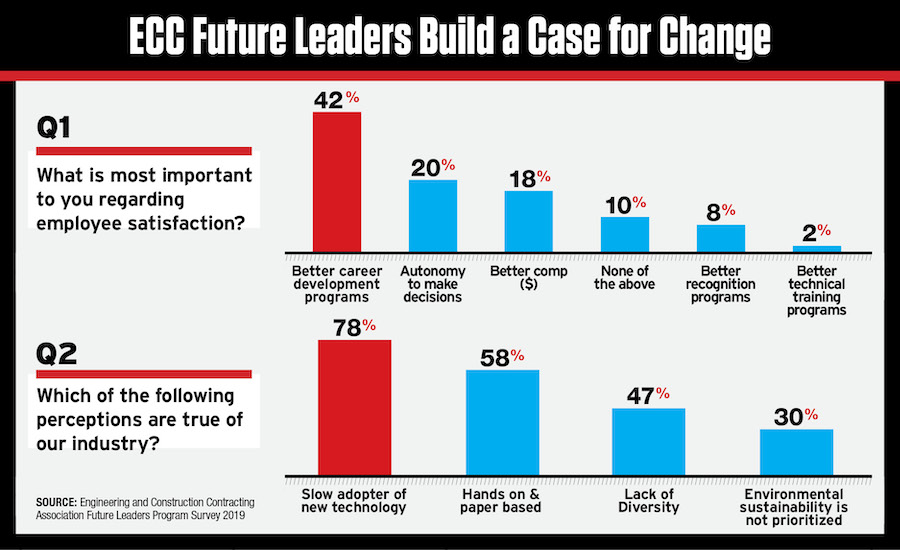How can construction firms attract and retain millennial and Gen Z employees? The Engineering and Construction Contracting Association’s Future Leaders program surveyed its members to find out and shared the results with attendees at the group’s national conference. Career development opportunity was the most important factor in retention, for example, ranking higher than authority to make decisions, compensation and recognition programs.
ECC is an industry group with roots in the oil, gas and chemical sectors that has broadened to attract global companies in many markets. Companies sponsoring the upcoming ECC conference each nominate an individual to participate in the program of thought leadership and professional development for three years.
“We received about 150 responses to the survey sent out to past and present program members,” said Ralph Rutanhira, associate principal at Westney Consulting Group, who worked on the research and moderated the session on Aug. 29 in Colorado Springs. “We crafted questions around people, work processes, governance and culture,” added Theresa Jensen, manager of corporate performance analysis for Zachry, who helped develop the session highlighting the voice of the Future Leaders group.
The survey results found that 78% of ECC future leaders found construction to be a slow adopter of new technology, and 47% said the industry lacks diversity. It also found that 47% of its future leaders found the technology sector to be more attractive for jobs than construction. That rang true to Martha Feeback, senior director of corporate engagement at Catalyst, who said that millennials and Gen Zs “live and breathe technology … so they look at companies who are nimble.” Heavy industry needs to do a better job at positioning its technology opportunities, she said.
Glenn Weckerlin, director of enterprise programs and partnerships at Chevron agreed: “We’ve got a lot of work to do at telling our story.” He said where Chevron excels is in creating a good intern experience. “We don’t have any trouble hiring people if we can get them to be an intern. We tell our story through reality, and 75% of our new hires come from that intern pool.”
Feeback said Catalyst, a nonprofit that works to accelerate progress for women, has studied the barriers to advancement of “underrepresented talent.” These are people who feel like “an other for whatever reason—even reasons that are not visible,” she said, a feeling that leads people to downsize their career aspirations. On the flip side, she added, feeling that the “manager has your back and you can speak up can lead to psychological safety, and that makes people stay” leading to diverse high-performance teams that drive innovation.
When they eventually get into the workforce, 66% of students who start school now will be in jobs “that do not exist today,” Feeback said. “If we continue to say these are the core competencies you needed for the old job, we are missing the boat. The competencies needed are changing.” She sees a bigger push required in the area of leadership change.
Feeback also cautions employers against seeking a “culture fit” in a new employee. “When you do that, you are going to have a homogeneous group of people, all thinking alike.” Instead, she recommends asking whether the individual “fits the missing piece” in the team that has an opening. That’s a very different way of looking at hiring and promoting.”
Weckerlin said Chevron CEO Michael K. Wirth was an early signer, along with 180 other CEOs, to the Business Roundtable statement on the purpose of a corporation, committing to lead their companies for the benefit of employees, customers, suppliers and communities as well as delivering value to shareholders. “That’s a big shift,” Weckerlin says, “Our CEO is all about the employee base—55,000 people. It starts at the top.”
By Janice Tuchman in Colorado Springs




Post a comment to this article
Report Abusive Comment